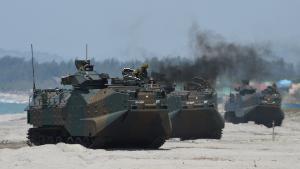Why you're seeing more of Japan's military
When tanks rolled and troops marched at a Japanese military base on Sunday, it was just the latest display in what analysts say is a campaign by Tokyo to increase the profile of its Self-Defense Forces.
Presiding over the display involving 4,000 troops, dozens of pieces armor and warplanes, including its newest F-35 stealth fighters, Prime Minister Shinzo Abe touted Japan's defense relationships extending as far as Europe.
"You're working on warning and surveillance activities, cooperating with allied countries, such as the United States, the United Kingdom, Australia, Canada, New Zealand," the Japanese Prime Minster told the troops assembled for the Japan Self-Defense Forces annual military review at Camp Asaka, just northwest of Tokyo.
Japan's military has been making its presence known thousands of miles from its home islands this year in what analysts say is intended to send a clear signal to China.
"China's ambition to dominate the Asia-Pacific region carries enormous consequences for Japan," said Timothy Heath, senior defense analyst for the RAND Corp. "It is in Japan's interest to build a capable military that deters China from rash actions and to help other countries balance politically and military against Chinese power."
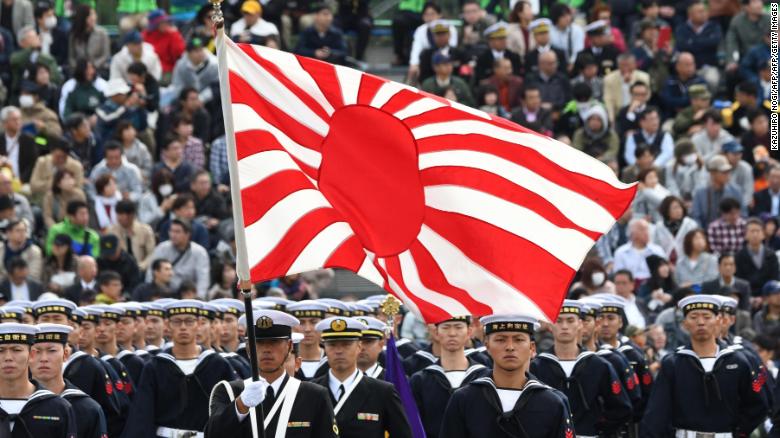
The flag of the Japan Maritime Self-Defense Force is seen in a military review at the Ground Self-Defence Force Asaka training ground in Asaka, Saitama prefecture on October 14, 2018.
In just the past two months, a naval force of three ships, including the 27,000-ton helicopter destroyer JS Kaga, has been on two months of exercises and port visits as far away as the Indian Ocean.
Among the exercises was an anti-submarine warfare drill in the South China Sea that included one of Tokyo's submarines. It was the first time Japan has acknowledged using a submarine in a drill in the contested sea.
That submarine then made a port call in Vietnam, which has its own claims in the South China Sea and has developed warming military ties with the US.
Meanwhile, Japan's ships on the naval deployment included visits to India, Sri Lanka, Singapore and the Philippines as well as drills with a British frigate in the Indian Ocean.
And earlier this month, Japanese amphibious vehicles operated on foreign soil for the first time since World War II, when they participated in joint exercises with US and Philippine troops, landing on the island of Luzon from the South China Sea.
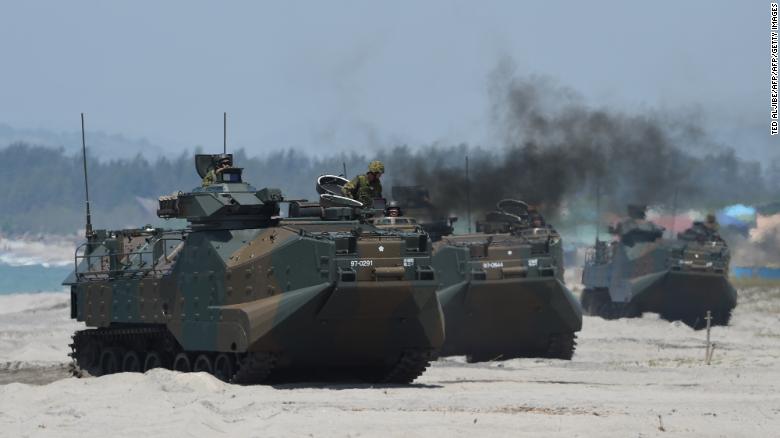
Japanese Ground Home Defence Forces' amphibious assault vehicles (AAV) hit the beach during an amphibious landing exercise at the beach of the Philippine navy training center facing the South China Sea in San Antonio town, Zambales province, the first time Tokyo's armoured vehicles rolled on foreign soil since World War II.
"There has definitely been greater SDF visibility beyond Northeast Asia and it is deliberate," said Corey Wallace, a security analyst at Freie University in Berlin.
Japan is "signaling to China that they can't count Japan out of any regional contingency whether the US is involved or not," Wallace said.
Constitutional restrictions
The US, with almost 50,000 troops in Japan, has been the anchor of Tokyo's defense since the end of World War II.
Japan's post-war constitution limits its military to defensive actions only, with Article 9 explicitly stating that "land, sea and air forces, as well as other war potential will never be maintained."
But those are restrictions have become increasingly murky as Tokyo maintains what by some estimations is the world's fifth most-powerful military and one that faces challenges from arms buildups from longtime adversaries North Korea and China.
In light of such challenges, Abe has set a goal of 2020 to amend the constitution to recognize the country's armed forces.
"In the course of the past five years, the environment of Japan's security has become tough in a remarkably fast speed," the Japanese Prime Minister said Sunday.
A Japanese defense white paper in August highlighted the concerns over China in that changing security environment.
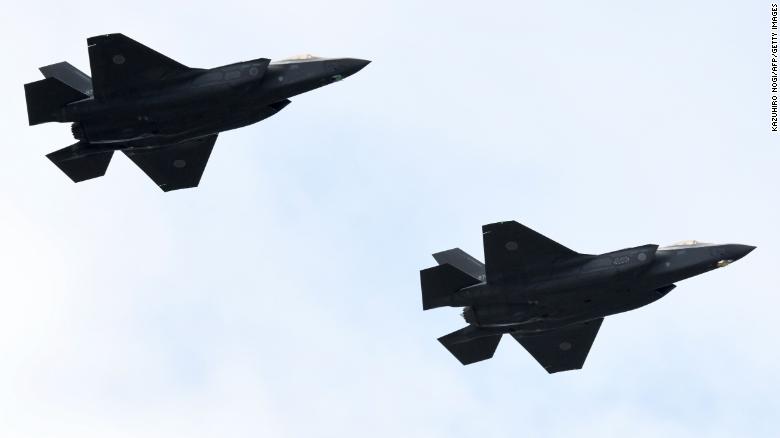
F-35 fighter aircraft from the Japan Air Self-Defense Force take part in a military review at the Ground Self-Defence Force's Asaka training ground in Asaka, Saitama prefecture on October 14, 2018.
"China's rapid modernization of the People's Liberation Army, enhancement of operational capabilities, and unilateral escalation of activities in areas close to Japan are generating strong security concerns in the region and international community, including Japan," the paper said.
And on Saturday, Japan's Air Self-Defense Force said the number of times it had to scramble fighter jets to respond to Chinese military planes increased 20% in the first six months of the current fiscal year compared to the same period a year earlier.
Becoming a regional player
Peter Layton, a former Australian military officer and now fellow at the Griffith Asia Institute, says Tokyo is on a "global soft power offensive" as it puts its forces into exercises with the likes of the United Kingdom, Australia and India.
"These relationships don't need to be unbreakable or reliable in the sense that their main purpose is to raise the level of uncertainty in the Chinese Communist Party's leadership's mind," Layton said.
"Would these other nations help Japan in time of trouble? Hard to say but they just might and thus multiply Chinese worries."
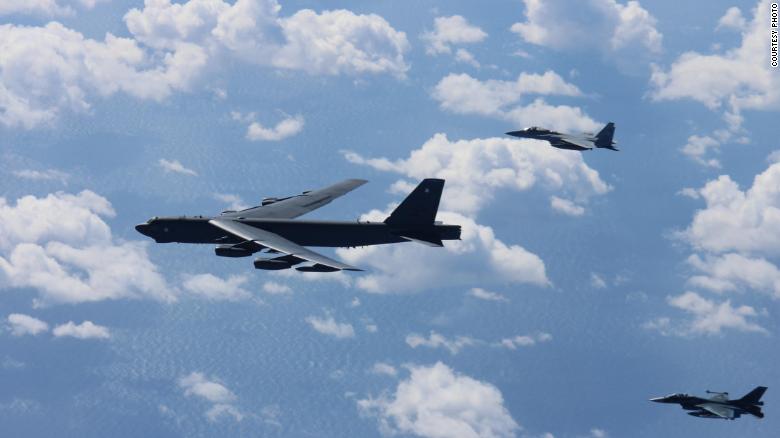
An Air Force B-52H Stratofortress bomber and a Japan Air Self-Defense Force F-15 and F-2 fighter execute a routine bilateral training mission over the East China Sea and the Sea of Japan, Sept. 26, 2018.
The notion of counter balancing the rise of Chinese military build-up is paramount, say analysts.
The defense white paper from August said Japanese forces had conducted 66 publicly announced military exercises with foreign troops between April 2015 and June 2018. That's up from 53 for the previous three-year period.
But more could be coming.
In an interview with Australia's ABC news last week, Japanese Foreign Minister Taro Kono said joint Japan-Australia patrols of the South China Sea were a possibility.
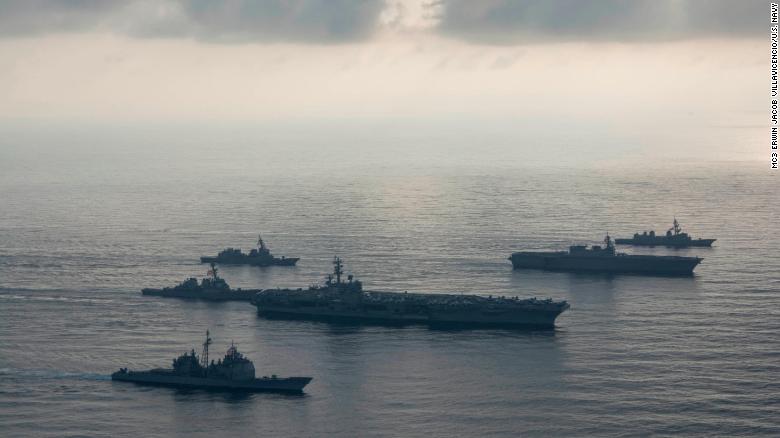
The aircraft carrier USS Ronald Reagan, second from bottom, the guided-missile cruiser USS Antietam, bottom, and the guided-missile destroyer USS Milius, left, conduct a photo exercise with the Japan Maritime Self-Defense Force helicopter destroyer JS Kaga , second from top, and the JMSDF destroyers JS Inazuma and JS Suzutsuki .
"South China Sea is obviously a very contentious region. We will consider what we can do together," Kono said following talks with Australian leaders.
Analysts said the far-flung exercises allow Japan to do something else: show off some of the advanced weaponry it can sell around the region.
"If these military missions are buttressed by economic linkages including arms sales so much the better," said Layton. "Economic linkages and arms sales help nurture a long-term robust relationship between Japan and the other nations."
"The missions are not strictly geopolitical or business: they are both intertwined, both aspects are important to deterrence succeeding," he said.
News Courtesy: www.cnn.com

